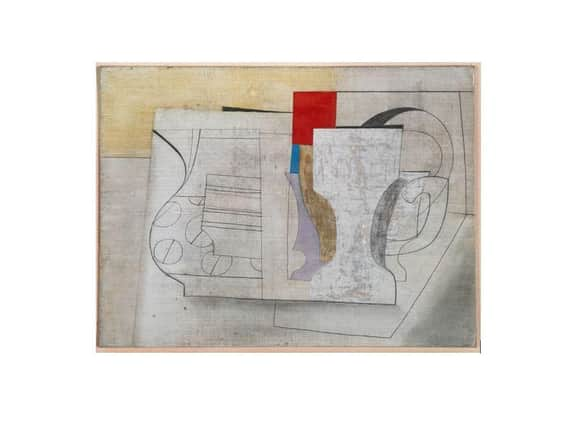Ben Nicholson is big summer show at Chichester’s Pallant House Gallery


Spokeswoman Hannah Vitos said: “The exhibition will explore the importance of still life and the studio within Nicholson’s art – from his early highly-finished paintings to the abstract reliefs that secured his international reputation.
“It will provide the unique opportunity to see over 40 paintings, carved reliefs and works on paper alongside the still life objects that inspired them, including his distinctive striped jugs, mochaware mugs and glassware.
Advertisement
Hide AdAdvertisement
Hide Ad“These objects were a vital presence in the numerous studios Nicholson inhabited during his life and were of central importance in his still life paintings.
“During a career spanning six decades, Nicholson used the humble still life as a vehicle for experimentation and at the same time reinvigorated the genre within modern art.
“The exhibition will include loans from private and national collections including Arts Council Collection, British Council Collection, Kettle’s Yard, and Tate, as well as several works from National Galleries Scotland and Pier Arts Centre, supported by the Weston Loan Programme with Art Fund.
“Although Nicholson regarded the still life theme as an inheritance from his father, the Edwardian artist William Nicholson, he strove to break with his traditional style of painting.”
Advertisement
Hide AdAdvertisement
Hide AdIn a letter to a friend, Nicholson recalled ‘I owe a lot to my father [...] not only from what he made as a painter, but from the very beautiful striped and spotted jugs and mugs and goblets, and octagonal and hexagonal glass objects he collected. Having those things in the house was an unforgettable early experience for me.’
Hannah added: “The objects were a vehicle for formal experimentation and Nicholson frequently incorporated them as subject matter in his paintings. The exhibition will bring together striking examples such as a 19th-century striped ceramic jug that Nicholson painted both in an early representational still life, 1914 (the striped jug) and a decade later, in one of his earliest forays into abstraction 1924 (painting-trout), in which the jug’s distinctive pattern remains, but its form is reduced to a flat rectangular plane.
“The exhibition will also explore the impact of the personal and artistic relationships Nicholson established during his life, notably his relationships with Winifred Nicholson and Barbara Hepworth Ben and Winifred Nicholson married in 1920, and for the first years of their marriage they lived in Switzerland at Villa Capriccio, where they established a simple domestic environment that captured their desire for a modern way of living. The couple returned to England in 1923 and soon set up home at Banks Head, a farmhouse in Cumberland where Nicholson developed a faux-naïve approach to painting, as can be seen in 1925 (jar and goblet).
“In 1928 on a visit to St Ives with painter Christopher Wood, Nicholson met the Cornish fisherman artist Alfred Wallis. The work of Wallis, often painted on irregular pieces of cardboard, confirmed Nicholson’s interest in the materiality of his work and a playful sense of lived experience, as can be seen in 1929 (fireworks).
Advertisement
Hide AdAdvertisement
Hide Ad“By March 1932, Nicholson had begun a new relationship with the sculptor Barbara Hepworth and was sharing her studio at 7 the Mall, in Hampstead. This new relationship was important to Nicholson’s working and thinking about art. He stated that ‘working-together in the same studio in those days was vital to my understanding of form’.
"Nicholson and Hepworth were considered pioneers of avant-garde British art and during visits to Paris spent time with Constantin Brâncuși, Hans Arp, Pablo Picasso and Georges Braque. It was during this time that Nicholson developed an interplay of different planes within a work and the conflation of space and depth. His work also took on a biographical viewpoint.
"in his still life paintings, as can be seen in works such as 1932-33 (musical instruments), which features the quasi-figurative form of two interconnected guitars, a reflection on his new relationship, and 1933 (piquet), which depicts two fish served on a dish, a bottle and cup, reflecting his enjoyment of a trip to France with Hepworth in the previous year. Nicholson made his first abstract carved reliefs in late 1933 including 1933 (six circles), which will be on display. These reliefs were initially carved free-hand and painted with muted colours, but by early 1934 they had developed into the celebrated white painted reliefs, featuring rectangular and circular forms, including 1936 (white relief). The balance of circular forms and rectangular areas, set within different planes, is a continuation of formal interests Nicholson had explored in his still life paintings.
“Nicholson’s studio settings and surrounding environments are often referenced in his work and form a central theme in the exhibition. In 1939, just before the outbreak of the Second World War, Nicholson and Hepworth moved to St Ives where he was to stay for nineteen years. It was in Cornwall that he painted his ‘still life-landscapes’, of which 22 July 1947 (still life - Odyssey 1) and 1946 (still life-cerulean) will be on display. In 1949, following a move to a large studio behind Porthmeor Beach, Nicholson began to undertake some of his important and large-scale still life paintings, which reference specific places in Italy including March 1950 (still life - Castagnola) and Sept 8-54 (Torcello).
Advertisement
Hide AdAdvertisement
Hide Ad“The final section of the exhibition will look at Nicholson’s years in Switzerland, where he moved in 1958. The dramatic landscape informed his carved reliefs that once again became a central part of his work, and the now familiar forms of his still life objects of jugs and goblets found new expression in his linear drawings and series of etchings.”